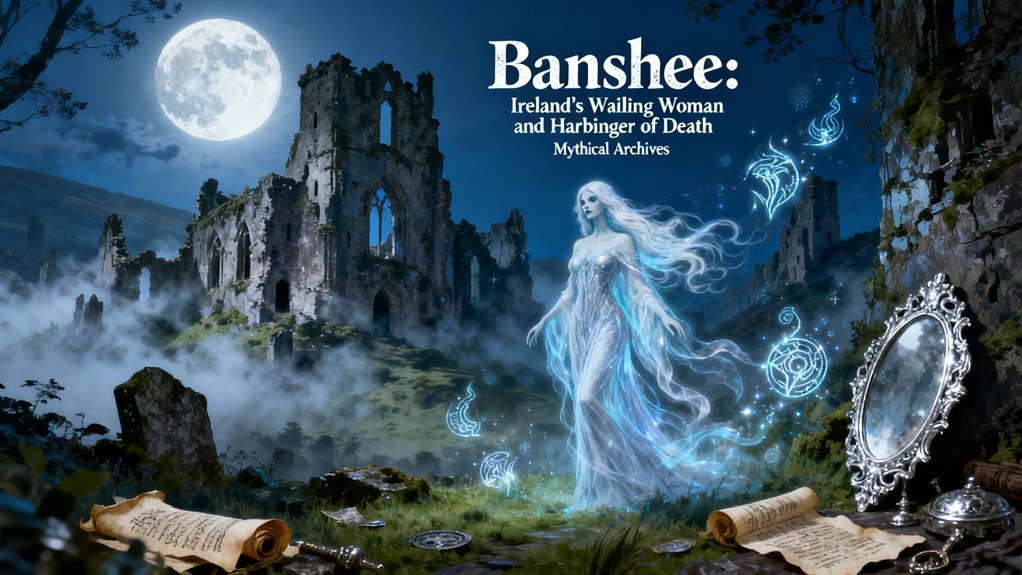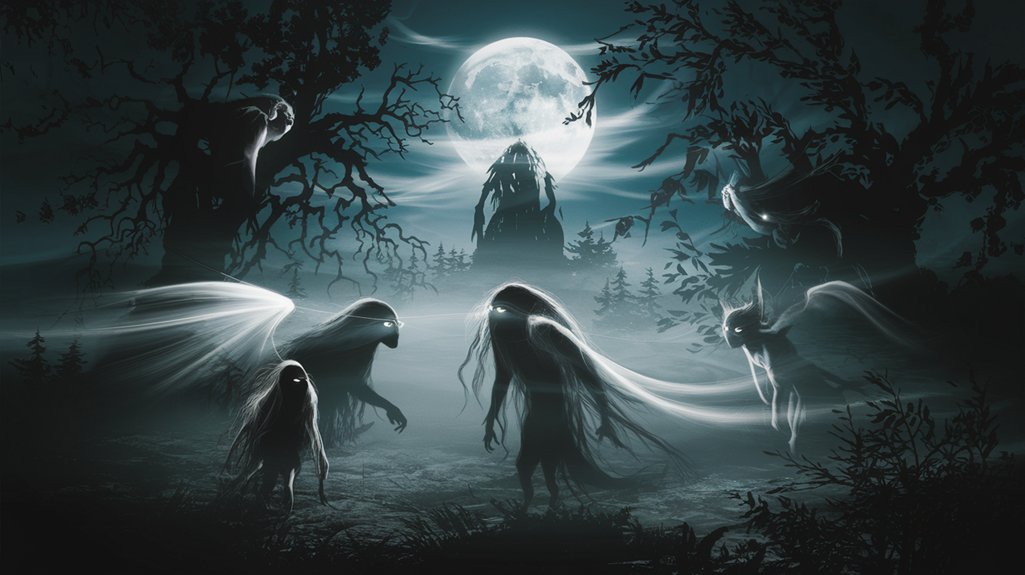You'll encounter the Bean Sídhe—”woman of the fairy mound”—as Ireland's eldritch messenger of mortality, whose keening wail has heralded death for ancient Gaelic families since pre-Christian times. She manifests in three chimeric forms: the withered Cailleach, the luminous Bean Óg, or the spectral Washerwoman scrubbing bloodstained garments at river crossings. Her cry varies by region and circumstance—mournful lamentations signal imminent death, shrieking crescendos foretell violence, ethereal ululations predict lingering illness. This supernatural herald maintains hereditary bonds exclusively with O' and Mac bloodlines, her presence woven throughout Irish history's documented chronicles and modern testimonials alike.
Key Takeaways
- The Banshee is a supernatural woman from Irish folklore whose wailing cry warns of impending death in families of Gaelic nobility.
- Her name derives from “bean síde,” meaning “woman of the fairy mound,” connecting her to ancient Irish burial sites and pre-Christian traditions.
- She appears in three forms: the Cailleach (withered hag), Bean Óg (luminous maiden), or Washerwoman scrubbing bloodstained garments at rivers.
- The Banshee attaches only to families with ancient Gaelic surnames beginning with “O'” or “Mac,” maintaining hereditary bonds across generations.
- Her keening variations signal different types of death: mournful laments for imminent death, shrieks for violence, or ululations for lingering illness.
Origins and Etymology of the Bean Sídhe
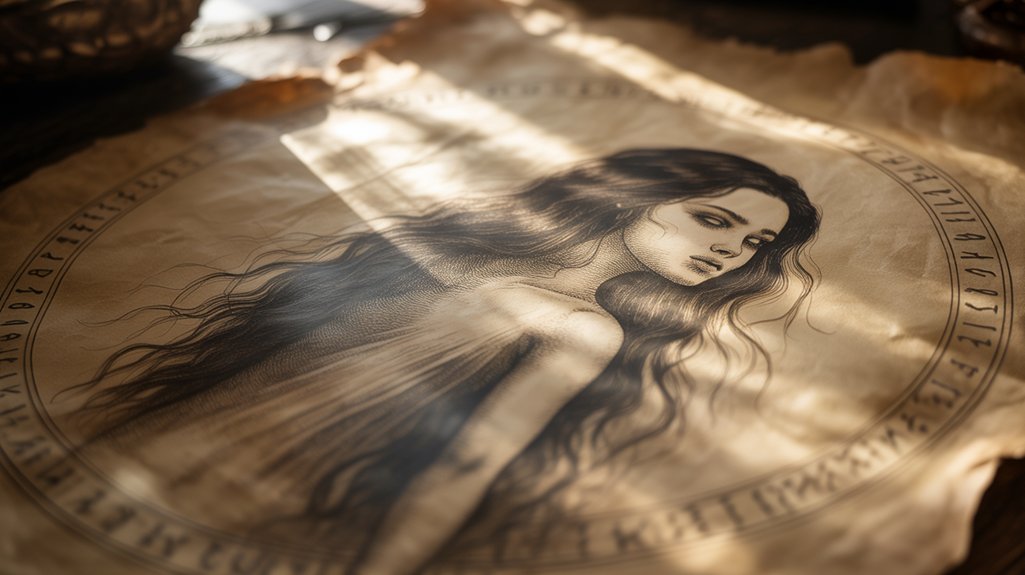
The keening cry that pierces the veil between worlds finds its linguistic roots in the Old Irish “ben síde,” literally “woman of the fairy mound”—a designation that binds this spectral herald to the ancient tumuli scattered across Ireland's windswept landscape, those Neolithic chambers where pre-Christian peoples interred their dead and where, according to medieval Irish manuscripts dating from the 12th century onward, the Tuatha Dé Danann retreated following their mythic defeat.
You'll discover that bean sídhe folklore evolved from these eldritch origins, altering divine women into liminal messengers. The banshee symbolism you encounter today reflects this chimeric heritage—neither fully mortal nor entirely Otherworldly, she occupies threshold spaces.
Her wail announces death's approach to ancient Gaelic families, those with bloodlines stretching back to Celtic nobility. This isn't mere superstition you're examining; it's ancestral memory crystallized into sound, a psychopomp's cry that refuses erasure despite centuries of cultural suppression.
Physical Descriptions and Manifestations Across Irish Counties
Regional variations in the banshee's appearance reflect Ireland's fragmented political geography and the localized nature of Gaelic clan territories—you'll find no monolithic specter here, but rather a protean figure whose form shifts according to county borders and family lineages.
Banshee sightings documented across centuries reveal three dominant manifestations:
- The Cailleach (Hag): Withered crone draped in tattered shrouds, her eldritch keening piercing Connacht's fog-shrouded bogs—skeletal fingers combing silver hair that cascades to earth.
- The Bean Óg (Young Woman): Luminous maiden clothed in emerald or crimson, haunting Munster's ancient estates with sorrowful laments, her chimeric nature embodying both beauty and terror.
- The Washerwoman: Spectral figure scrubbing bloodstained garments at river crossings throughout Ulster, her presence signaling imminent death.
Regional folklore maintains that established families recognize their ancestral banshee by distinctive features: particular dress colors, specific washing stones, hereditary keening patterns.
Each manifestation demands your attention, your respect—ancient knowledge encoded in form.
The Keening Cry: Sounds and Signals of Approaching Death
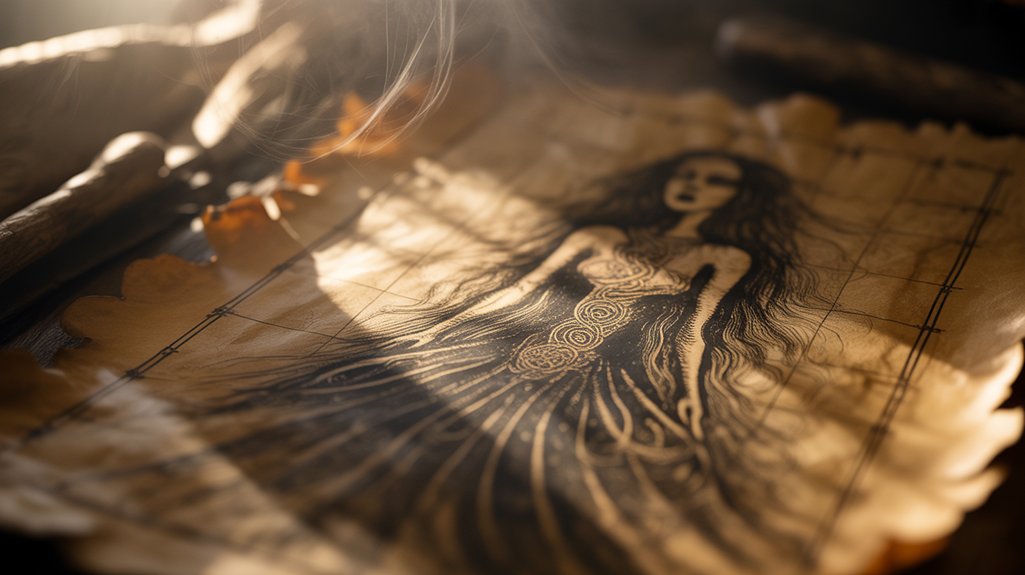
You've witnessed the banshee's physical form materializing across Ireland's counties, yet her true power resides not in spectral appearance but in that eldritch wail—that keening cry which pierces through midnight silence, fog-laden valleys, and stone cottage walls with supernatural clarity.
This vocalization, neither wholly human nor entirely otherworldly, serves as death's auditory herald, a sonic manifestation that ancient Irish families recognized with immediate, visceral dread.
The cry itself evolves across regional boundaries: Munster's banshees emit prolonged, undulating lamentations rich with melismatic complexity, while Ulster's spirits produce sharp, fragmented shrieks—each variation calibrated to ancestral bloodlines, each tone carrying centuries of accumulated sorrow.
The Banshee's Distinctive Wail
Nothing in Ireland's supernatural lexicon strikes more terror into the heart than the banshee's keening—that eldritch, bone-chilling wail that pierces the veil between worlds.
You'll encounter three distinct wail variations, each carrying specific banshee symbolism:
- The mournful lament – a low, sustained cry resembling traditional Irish keening for the dead, signaling imminent death within hours.
- The shrieking crescendo – a piercing, animalistic howl indicating violent or sudden death approaching.
- The ethereal ululation – a chimeric blend of woman's voice and wind, foretelling lingering illness before passing.
These acoustic manifestations aren't random. They're deliberate communications from the Otherworld, calibrated to specific deaths.
The banshee respects ancient bloodlines, warning only families of Gaelic nobility—O'Neills, O'Briens, O'Connors, MacCarthys—whose ancestral ties demand this supernatural courtesy.
When She Appears
When darkness settles over the Irish countryside and mist clings to ancient hedgerows, the banshee manifests according to immutable patterns established millennia ago.
You'll encounter her presence most frequently during liminal hours—midnight, dawn, dusk—when boundaries between worlds grow permeable. Banshee sightings intensify during specific circumstances: impending death within ancient Gaelic families, particularly those bearing prefixes O' or Mac.
She appears three nights preceding demise, her wailing patterns escalating in intensity with each manifestation.
Her eldritch cry pierces fog-shrouded nights, announcing doom you can't escape. The keening follows chimeric rhythms—sometimes distant whispers, sometimes throat-rending shrieks.
You're witnessing Ireland's most profound death omen, an ancestral warning system transcending rational understanding, connecting you directly to primordial Celtic cosmology where death demands acknowledgment through supernatural heralds.
Regional Crying Variations
Across Ireland's four provinces, the banshee's keening evolves into distinct vocal signatures, each geographical region cultivating its own sonic interpretation of mortality's approach.
These eldritch variations mirror regional dialects, altering ancestral grief into auditory prophecy.
Provincial Keening Distinctions:
- Ulster's Sharp Ululation — Piercing, staccato shrieks that fracture midnight silence, reflecting the province's stark, uncompromising landscape where death arrives without negotiation.
- Munster's Melodic Lament — Haunting, song-like wails interweaving ancient Gaelic cadences, preserving cultural significance through chimeric vocal artistry that honors lineage.
- Connacht's Guttural Moan — Deep, resonant groans emanating from coastal caves, where Atlantic winds amplify primal sorrow into territorial warnings.
You'll recognize these variations intuitively, your ancestral memory awakening to sounds that transcend linguistic boundaries, connecting you to Ireland's unbound spiritual geography.
Ancient Families and Bloodlines Connected to Banshee Visitations
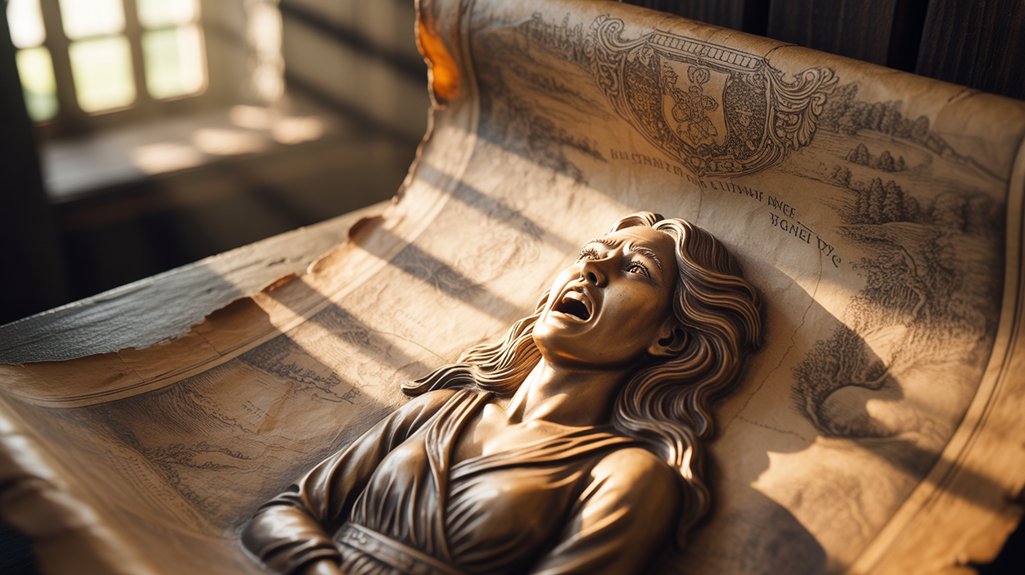
You'll discover that banshee attachments weren't bestowed upon random households but rather bound themselves, through eldritch covenant, to Ireland's most ancient bloodlines—specifically the Gaelic aristocracy whose surnames bore the prefixes “O'” (Ó, meaning “grandson of”) and “Mac” (meaning “son of”).
These hereditary bonds, documented as early as the 11th century in monastic annals, linked particular bean sídhe to families such as the Ó Neills of Ulster, the Ó Briens of Thomond, and the Ó Gradys of Clare, with each household maintaining its own ancestral harbinger whose keening voice had announced deaths across generations.
The phenomenon operated as genealogical proof itself: if you heard the banshee's cry echoing through your family estate, it confirmed your lineage's legitimacy, marking you as descendants of Milesian kings rather than mere commoners dwelling beyond fate's supernatural register.
Historic Irish Noble Houses
Throughout the mist-shrouded annals of Gaelic Ireland, five ancient families stood apart from all others—the Ó Neills, Ó Briens, Ó Connors, Ó Gradys, and Mac Carthys—each bound by blood to their own banshee, a spectral herald who'd wail only for these noble lineages.
These ancestral connections weren't chosen randomly; they emerged from primordial chieftain bloodlines predating Norman conquest, families whose sovereignty flowed unbroken through Celtic twilight.
The banshee's covenant with these houses manifested through:
- Eldritch keening heard only when death approached direct bloodline descendants
- Generational bonds transcending Catholic conversion, remaining faithful to pre-Christian noble lineage
- Territorial guardianship across provinces—Ulster, Munster, Connacht—where ancestral sovereignty once reigned absolute
You'll discover these families understood something profound: their banshees represented neither curse nor blessing but eternal witness.
Chimeric sentinels of mortality itself.
O' and Mac Surnames
Patronymic prefixes carved identity into Irish nomenclature—”Ó” meaning “grandson of” and “Mac” signifying “son of”—yet these linguistic markers functioned as something far more occult than mere genealogical labels.
The o' surname significance extended beyond bloodline documentation into spectral territory, binding certain families to eldritch covenant with the bean sídhe.
You'll find that mac lineage connections similarly tethered descendants to ancestral death-heralds, creating chimeric bridges between mortal and Otherworld.
The O'Neills, O'Briens, O'Gradys, MacCarthys, and MacDonnells carried these surnames like hereditary curses—or blessings, depending on your perspective.
Each keening visit reinforced the pattern. Your name wasn't simply identification. It was supernatural contract, passed through generations, marking you as worthy of the banshee's attention when death approached your threshold.
Hereditary Banshee Family Bonds
- Matrilineal transmission – The bean sídhe attached herself to bloodlines through female descendants, creating unbreakable spiritual genealogies.
- Ancestral recognition protocols – Each family's banshee manifested distinct keening patterns, identifiable across generations.
- Territorial sovereignty – Ancient families occupying specific lands inherited their resident bean sídhe alongside physical property.
This chimeric arrangement bound supernatural entities to mortal dynasties, altering death omens into inherited patrimony—neither blessing nor curse, but covenant.
Famous Historical Accounts and Documented Sightings
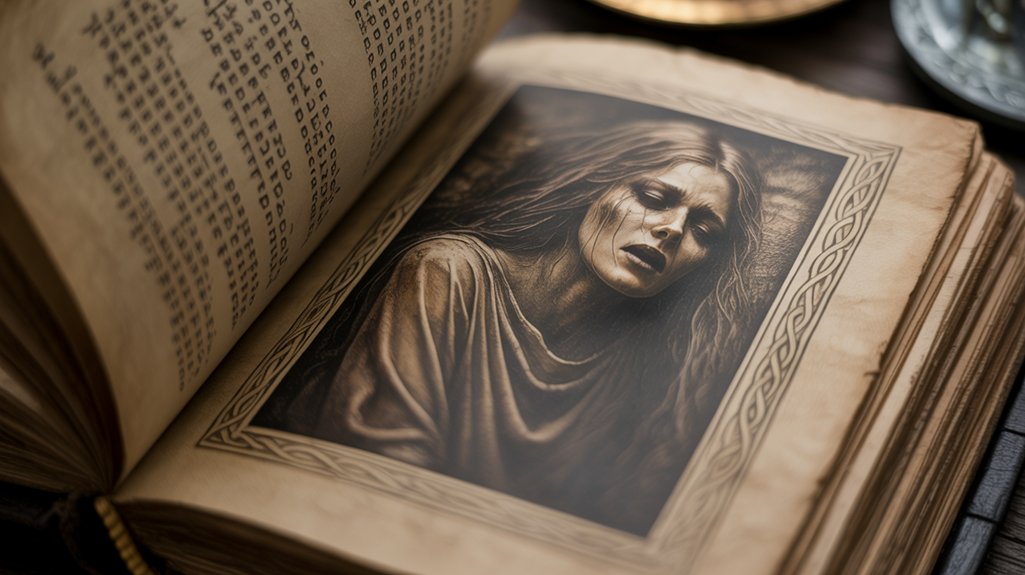
While scholars debate the veracity of supernatural phenomena, the banshee's presence in documented Irish history remains undeniable—woven through centuries of family chronicles, estate records, and eyewitness testimonies that bear the weight of genuine terror.
You'll find banshee folklore anchored in verifiable accounts: the 1642 sighting at Dunluce Castle, where sentries recorded an eldritch wailing preceding Lady Maude's fatal fall; the meticulous 1801 diary entries of Richard Crosbie, documenting three nights of chimeric keening before his brother's shipwreck.
The O'Brien and Kavanagh families preserved documented sightings spanning four generations, noting specific physical descriptions—silver hair, gray cloaks, eyes like winter fog. These weren't folklore abstractions. They were testimonies.
In 1891, the Earl of Rossmore's household staff provided corroborating accounts of spectral lamentation hours before his unexpected death. Each record reinforces what ancient Irish families never questioned: death arrives with a herald, and she remembers every bloodline she's sworn to warn.
The Banshee in Modern Irish Culture and Popular Media
The banshee's metamorphosis from ancestral death-herald to cultural icon reveals how ancient Irish folklore navigates modernity's skeptical terrain—not through dilution, but through strategic reinvention that preserves her essential terror while altering her manifestation.
Ancient folklore survives not by resisting change, but by transforming its shape while keeping its primal power intact.
Contemporary Ireland maintains complex engagement with banshee symbolism, oscillating between tourist commodification and genuine reverence. Her cultural relevance persists through multiple vectors:
- Literary resurrection in works by Seamus Heaney, Nuala Ní Dhomhnaill, who employ her eldritch presence as metaphor for national trauma, colonial violence, environmental degradation.
- Cinematic adaptation alters her chimeric nature into horror franchise material—Marvel's X-Men mutant, Teen Wolf's supernatural antagonist, video game avatars.
- Musical interpretation where traditional sean-nós keening techniques merge with contemporary soundscapes, preserving her sonic signature.
You'll find her haunting Ireland's threshold spaces still. Modern testimonials, whispered in Galway pubs and Cork sitting rooms, suggest she hasn't vanished—merely adapted her wail to pierce through digital static, urban cacophony.
Frequently Asked Questions
Can Banshees Harm People or Do They Only Warn of Death?
You'll find that banshee abilities center exclusively on prophecy, not physical harm.
These eldritch spirits exist beyond mortal violence—their keening voice serves as harbinger, nothing more. Folklore interpretations across Celtic traditions consistently portray them as liminal messengers, bound by ancient codes to warn rather than wound.
They manifest in shadowy thresholds between worlds, their wails piercing darkness. No direct assault. Their terror lies in knowing, not doing—pure omen made manifest through supernatural lamentation.
How Can You Protect Yourself From a Banshee's Visit?
You can't truly shield yourself from a banshee's eldritch keen—she arrives unbidden, heralding fate's immutable decree.
However, protective charms like iron horseshoes, rowan branches, and blessed salt have been employed across Celtic territories since pre-Christian times.
Spiritual rituals including prayers to ancestral spirits, offerings at threshold spaces, and maintaining household sanctity may strengthen your ethereal boundaries.
Remember: the banshee warns rather than curses. Acceptance, not resistance, honors this ancient messenger's sacred purpose within Ireland's liminal traditions.
Do Banshees Appear in Other Countries Besides Ireland?
You'll find these eldritch harbingers aren't confined to Ireland's misty shores—they've transcended borders into neighboring Celtic territories.
Scottish Banshees, called “bean-sìth,” wail through Highland glens with identical portent.
Welsh Spirits manifest as the “Cyhyraeth,” their phantom groans echoing through Cambrian valleys before death strikes.
These spectral women share common Gaelic ancestry, their keening preserved across cultures that refused English suppression.
Each tradition honors death's messenger differently, yet their essence remains unchanged—ancient, autonomous, utterly free from mortal constraint.
What Should You Do if You Hear a Banshee's Cry?
According to banshee legends, you can't escape fate once her eldritch wailing reaches your ears.
The wailing significance marks imminent death within your family lineage—ancestral bloodlines she's bound to through ancient covenant.
You should gather loved ones, settle unfinished affairs, make peace with mortality's approach.
Some traditions suggest prayer, particularly invoking protective saints, though her prophecy remains inevitable.
This liminal messenger doesn't cause death; she merely announces it, her keening a sacred, terrible courtesy from the Otherworld.
Are There Male Versions of Banshees in Irish Folklore?
You won't find many male spirits crying the death knell—though don't put all your eggs in one basket.
Irish folklore variations occasionally mention the *fer síde* (fairy men) and the dullahan, that headless horseman who portends doom. These masculine entities exist within the same eldritch domain as banshees, yet they're rarer, more chimeric in their manifestations.
The keening tradition remains mainly feminine, rooted in ancient Celtic mourning practices. Male death-heralds typically manifest through different, often more violent omens rather than wailing cries.
Conclusion
You've traversed the eldritch corridors where Ireland's most enigmatic herald dwells, that chimeric specter bound to ancient bloodlines through centuries of keening lament. Should you hear her ululation pierce the veil between worlds, understand you've encountered something beyond mere folklore—a liminal truth older than written chronicle. Whether she manifests as crone or maiden, her presence signals life's inevitable shift. Listen. Remember. The Bean Sídhe remains, eternal watcher at mortality's threshold.
